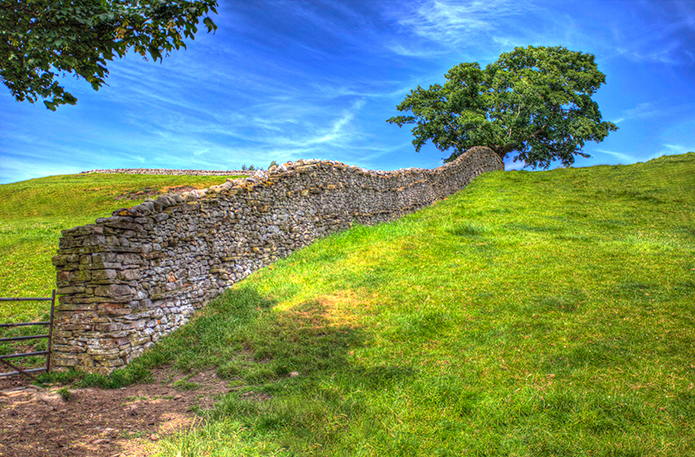
Dry stone wall near Askrigg, Yorkshire Dales.
My earliest memory of dry stone walls comes from when I was about 8 years old, when on holiday in the Yorkshire Dales; I found a baby shrew sat on a stone protruding out of one of the dry stone walls near to where we were having a picnic. I was told by my mother that it probably lived in the wall, and I was puzzled and transfixed as to how an animal could actually live in the middle of a wall. It wasn’t just shrews either, I learned that field mice, voles, stoats, hedgehogs, bats, toads and slow-worms all made their homes amidst the wall, and hares will scrape a hollow at the base of a wall where it will remain sheltered from the worst of the elements. Many birds too, such as the robin, wheatear and redstart, and the occasional small owl, have been known to occupy larger gaps, with mosses, lichens and ferns favouring the outside of the walls.
I vaguely recollect asking my mother lots of other related questions, such as how the walls managed to stand up what with all the gaps in them, where all the stone came from to build them, who built them, and why they were built in the first place. The fact they were built a long, long time ago, and the animals and plants made the wall their home, or used them as hiding places from predators, was about all I remember from my early questions.
A thing of beauty
We returned to the same spot in the Yorkshire Dales each year for the following ten years with my family, and I’ve been returning to the same area every year since with my girlfriend, who became my wife, and our children. Each year I’ve been back, I’ve learned a little bit more about dry stone walls, and appreciate their beauty more and more. So much so that I went on a couple of dry stone walling courses to learn how to make them myself. It’s difficult to explain to someone who hasn’t been to an area such as the Yorkshire Dales just how beautiful dry stone walls are, and how much they are intrinsically part of the fabric of the landscape of the area, particularly where the stone used reflects the underlying geology, and the same colour and texture of stone, and vernacular style, that is used for wall building is used to build other structures in the landscape, such as field barns. Anyone who can remember watching the TV series All Creatures Great and Small in the 1970s and 1980s will have an idea, but you really need to visit the Yorkshire Dales to appreciate the beauty.
I don’t think I’m alone either in appreciating their beauty either. The beauty, improvisation and simplicity of building a structure made from locally available stone, and nothing else, by arranging the stones in a particular pattern so that they lock themselves together to create a solid structure that can last for hundreds of years, is shared by many; certainly judging by the amount of Royal Horticultural Society medals that have been won in show gardens recently where dry stone walling has been a key feature.
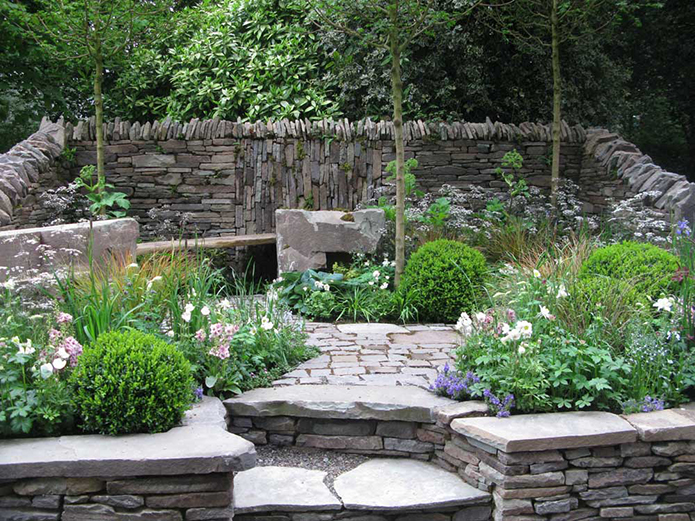
‘Un Garreg’ (One Stone) Artisan Garden, RHS Chelsea Flower Show 2013, London. Image courtesy of Gail Durbin via Flickr.
They are extremely eco-friendly as well, leaving no carbon footprint (as cement isn’t required), and the flora and fauna appreciate them enormously, providing a valuable habitat for a wide range of wild plants and creatures, and are effectively one huge linear nature reserve.
Where they are found
I’d always thought that dry stone walls were a peculiarly British and Irish phenomenon, but that’s not the case and anyone who has watched the film The Shawshank Redemption will know that as well. Andy (played by Tim Robbins) hides a stash of cash and set of instructions inside a tin hidden within an abandoned ‘rock wall’ (the American term for a dry stone wall) besides a huge oak tree ready for ‘Red’ (played by Morgan Freeman) to find on release from prison. The location for the scene was meant to be in New England, an area famous for its rock walls (it was estimated that by the 1870s, New England and New York had over 250,000 miles of stone walling), but it was actually filmed in Mansfield, Ohio, but sadly the wall has gone now apparently, thanks to souvenir hunters who have taken it apart and sold the stones on eBay. Dry stone walls are also found throughout Pennsylvania, New Jersey, Virginia, and parts of Kentucky (the Bluegrass Region) and California (Napa Valley).
Dry stone walls aren’t just limited to the British Isles and USA either; they’re actually found throughout the world and span a variety of civilisations; dry stone walls can be found in Canada, Iceland, Norway, Sweden, France, Germany Spain, Italy, Canary Islands, Croatia, Czech Republic, Zimbabwe (the ruined city of Great Zimbabwe was predominantly made from dry stone), Australia and New Zealand (due to more recent migration from the British Isles), Belize and Peru (the Inca built Machu Picchu using dry stone construction). Dry stone is very popular within high frequency earthquake regions because the walls are very flexible (not having solid concrete joints), and they are constructed of two rows of walls that incline towards each other (the angle or gradient of the walls is known as ‘the batter’), so when the ground shakes, the stones move inwards towards each other, not outwards towards people!
In Britain, dry stone walling is usually found in rocky Highland or Upland areas such as the Pennines, the Lake District, the North East, the Peak District and throughout most of Wales and Scotland and parts of South West England (Cornwall and Devon mainly). An exception to this is the lowland Cotswolds (although a few hills do attain to 1,000 ft or more), which went through an extensive wall building period due to the Parliamentary Enclosures in the middle of the 18th and 19th Centuries, a period that saw the Cotswolds being the centre of the woollen industry in England, made possible by the availability of stone found under the thin soil across the Cotswold landscape; the subsoil rock is extremely accessible (being only a few inches deep in many places) which provides both a strong base on which to build the walls and makes stone extraction easy, as the stone breaks down with ease into flat rectangle shapes, perfect for shaping into a wall (and also fracturing into roofing slates).
Cotswold masons have perfected the artistry of gentle 3 or 4 ft walls, often single-skinned (one wall, instead of two) adequate for their genteel Cotswold sheep; totally impractical for the rough Pennine environment (of wind, rain, frost and snow) and the tough Blackface sheep that require 6 ft high walls of considerable thickness due to their sharp wit for spotting a gap, and considerable strength.
History of walling
Dry stone walling is an ancient craft that goes back thousands of years since the Neolithic period. Evidence of dry stone wall and house construction at Skara Brae on Orkney has been radiocarbon dated back to c3200 BC, amazingly preserved as it was buried by sand dunes until the farmstead was discovered in 1850. Newgrange burial mound in Ireland has been dated to the same period. It’s even been thought that an earlier farmstead on Orkney, the Knap of Howar, may actually date from 3700 BC, although the radiocarbon dating isn’t precise. What we do know is that dry stone walling is a technique that’s been around over 5,000 years.
Bronze and Iron Age farmers used dry stone walls for field walls or boundary walls, once the practice of nomadic hunting and pastures gave way to settled farming, to safeguard stock and horses. Co-axial field systems were adopted, so-called because their main boundaries were parallel or co-axial, and the boundaries were made of lines of stones or low, broad dry stone walls, with facing stones enclosing a rubble core. It’s thought some were grassed over, and may have carried fences or hedges (in a way, similar to how the regional dry stone walls in Cornwall and Devon are made), but it’s unlikely they were entirely stock-proof by themselves due to the height of them. Within the settlement areas, there are many examples of dry stone walling construction, including cairns, and foundations for irregular and round house settlements. Much of the evidence of Bronze and Iron Age field systems is lost now due to modern cultivation techniques, forestry plantations and re-use of stone by later generations, but evidence does exist on Calverside Moor, Burton Moor and Fremington Edge in Swaledale, within the Yorkshire Dales.
Well preserved examples of Iron Age dry stone walling still exist in the form of ‘brochs’, military defensive or offensive structures to some archaeologists, elaborate farmsteads to others; no one is quite decided what they were for. However, they are huge structures, some more than 40 ft high, such as Mousa Broch on the Shetland Isles. They probably survived intact so well over the centuries due to their sheer size and strength (the walls are up to 10ft thick). There is also some dispute as to who built them; some archaeologists believe they were built by indigenous people (on behalf of a locally powerful Lord); whilst others believe they were built by immigrants from South West England who moved northwards to escape the advancing Romans. Whilst accurate dates for when they were built is unknown, the commonly held view is that they were built around 100BC to 100AD.
Celtic tribes, such as the Carvetti, Parisii, Brigantes, Corieltauvi, Cornovii and Votadini, had been successful in farming upland and highland areas, and the Brigantes in North Yorkshire, for instance, had been known to enclose fields and grew crops such as wheat and peas around communities settled high on Penhill and Addlebrough. The Roman invasion pushed the Celtic tribes to the western peripheries of Britain.
The Romans, particularly in the early period (before they invented their opus caementicium mortar), developed dry stone walling from irregular walling, such as that built by the Celts, and which the Romans termed Cyclopean masonry as found in Mycenaean architecture (the term comes from the belief that only the mythical Cyclopes had the strength to move the massive boulders that made up the walls), to more regular, ordered and precise dry stone walling such as Isodomum and Opus quadratum construction (found throughout the Empire), for building walls, temples, reservoirs, terraces and temple podiums, examples of which include the Forum of Augustus (Foro di Augusto) and the Servian Wall (Mura Serviane). Some of these dry stone walls are so precise, they are almost indistinguishable from the later structures where mortar was used.
Dry stone walling fell out of favour in Britain in the Dark Ages in England, with the arrival of the Angles and Saxons, mainly because they tended to settle in the largely ‘wall-less’ lowlands, where their lowland agricultural techniques were more successful than highland farming, as favoured by the various Celtic tribes.
The next real phase of dry stone wall building in Britain started in the early Middle Ages, from later Anglo-Saxon to Viking times as the number of settlements increased, and upland and highland areas began to be farmed more intensively. The Vikings were prolific dry stone wall builders, both for livestock protection and for houses and churches, but the larger structures required regular stone found in bedding plains for the ease of building, as irregular shaped stones really needed mortar (as favoured by Anglo-Saxon church builders). The Vikings extended their settlements from towns and cities such as Grimsby and Jorvik (York), into the countryside, particularly into upland areas within Yorkshire in the 8th and 9th centuries; the legacy they left behind includes remnants of their farmsteads and walls, as well as place names, words and dialects still spoken today (such as Broad Yorkshire or ‘Tyke’). Many commonly used words used and spoken today in the Yorkshire Dales derive from Viking, such as ‘gill’ (ravine), ‘foss’ (waterfall), ‘thwaite’ (clearing) and ‘keld’ (spring).
The Viking influence of dry stone walling wasn’t just found in Britain, but indeed throughout all their lands, including Iceland, Greenland, Ireland and Newfoundland, Canada. Remnants of dry stone walls and foundations for farmsteads are found at L’Anse aux Meadows in Newfoundland, and the Norse Church of Hvalsey in Greenland, dating from the 12th Century, was made of dry stone construction, although evidence suggests it may also have been clad in mortar.
It has been suggested by the author Farley Mowat in his book the Farfarers, perhaps inspired by Canadian archaeoligist Thomas Lee’s excavations in Ungava, northern Quebec in the 1960s, that even before the Vikings, pre-Celtic explorers and traders from the Orkney Isles, off Scotland, hunted for walrus ivory around the East Coast of Canada using double-ended open boats made with walrus hides covered in walrus-blubber tar. As the hostile landscape was treeless and windswept, the explorers flipped their boats upside down and placed them on top of dry stone wall foundations to create boat-roofed houses to shield them from the weather.
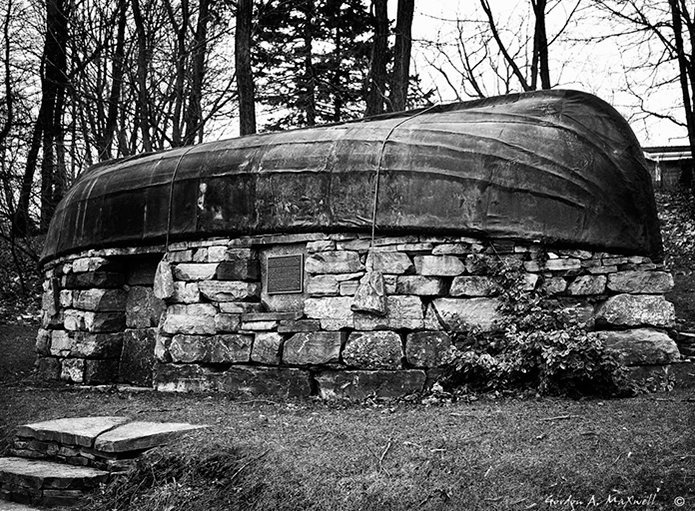
Small-scale replica of boat used by walrus hunters inspired by archaeologist Thomas Lee’s excavations in Ungava, northern Quebec. Port Hope, Ontario. Image courtesy of Gordon Maxwell via Flickr.
Whether or not these explorers actually existed at that time, or practised this technique on a widespread basis, what is undeniable is that the technique was proved to be effective. The explorer Ernest Shackleton, and his men, stranded on Elephant Island during the ill-fated Imperial Trans-Antarctic Expedition 1914-1916, lived in huts made of dry stone walls with an upturned boat as a roof (covered in a veneer of sealskins, instead of walrus, and tarpaulin) for four-and-a-half months in harsh conditions, so it was plausible that the practise was carried out around the time of the Vikings, and even before.
The Norman Conquest didn’t have a profound effect on dry stone walling; if anything it hindered the development in the North of England. The scorched earth policy of the Normans in 1069-70 to subjugate the Angles, Saxons and Danes in the north of England under Norman control, The Harrying of the North, as it was called, left 100,000 dead, either as a result of genocide or starvation, and the area took decades to recover. Some of the Norse Vikings who had settled in the Yorkshire Dales, for instance, were spared from the massacre and allowed to continue raising their livestock (maybe because the Norse Vikings were effectively cousins of the Normans, or ‘Norseman’ as they originally came from Scandinavia before settling in Normandy, France?) provided that they took care of the Norman deer and hunting grounds.
The Augustinian and Cistercian monks and nuns of the 12th and 13th Centuries built dry stone walls around their church yards and monastic buildings as the clergy began to enclose larger areas of land to clear the fields as well as enclose the monasteries’ pastures. Dry stone walls were preferred, as the humble and purist construction techniques were symbolic of their theological foundation. They tended to favoured remote locations, examples of which can still be found at Fountains Abbey, Jervaulx Abbey, Ellerton Abbey and Bolton Priory in North Yorkshire.
Dry stone walls were an ideal choice for medieval farmers. They were used as field boundaries for infield areas (fields next to farmhouses), for divisions within these fields, for outfield pasture boundaries further away from the farmhouses, to stock proof managed woodland, such as coppice areas, for shelter walls and stock handling facilities. Sheep often like to shelter behind dry stone walls, keeping themselves out of the rain and strong wind; the gentle draughts that pass through the gaps in parts of the wall can help dry out a wet animal sheltering behind it, which is a huge advantage at lambing time when cold wet weather can affect the survival rate of lambs. The reduced maintenance requirements of dry stone walls would be very important for livestock husbandry, especially if there were seasonal shortages of labour.
The next definable period of wall building in Britain commenced in the 15th Century, at a time when English society moved away from feudalism and common farming towards enclosure of common farming land and individual holdings. Common land (land which had been owned or used “in common” by all inhabitants of a village), was becoming enclosed by dry stone walls in lowland and upland areas as landowners sought ways to restrict the rights of villagers on their lands, and more intensive sheep and cattle farming established itself; although it’s thought that outlying pastures were still used for grazing animals, and the enclosed land was used for growing crops. The walls lacked refinement and didn’t have a regular layout.
As sheep flock sizes increased, larger enclosures were built for pastures, as well as increased crop production in some cases. From the late medieval period through to the late 16th Century, the lower slopes of upland and highland areas become enclosed by dry stone walls; the fields tending to be fairly small by today’s standards. The enclosures were still of irregular shape, but the walls tended to be built in straighter segments, and construction methods were being refined.
By the 17th century, land slightly higher up the hills and mountains became enclosed by the walls, and fields became larger. The 18th and 19th centuries saw the higher land becoming enclosed during the period of the Enclosure Movement passed by Acts of Parliament; these allowed landowners to enclose vast tracts of land, and the walls run for many miles and are more regular and ordered in appearance. The Acts were a series of over a thousand separate acts spanning a hundred years from around 1750, promoted by the wealthy, to allow land to be enclosed, and effectively stripping away the common land needed by farmers to survive. Many ‘commoners’ were forced into poverty, while the new land owners became very wealthy. Over 7 million acres, or 21% of England, was enclosed throughout this time, but the majority was carried out between the 1801 Enclosure Consolidation Act and the 1845 General Enclosure Act. Whilst the social effects for the poor were deplorable, the effect on walls and walling was profound, as thousands and thousands of dry stone walling was created in upland and highland areas (as well as lowland Cotswolds).
There was also demand for dry stone walling for non-agricultural purpose. The road system in Britain was upgraded, as the original system of roads was unsuitable for the carriage of goods over long distances. There were increasing numbers of heavy horse-drawn wagons associated with the increase in trade between towns, cities and ports. Attempts had been made in the late 1600s to improve roads through the turnpike system, and this continued until the mid 1700s; however roads were still atrocious, with stagecoach speeds of 5mph considered quite reasonable. With increasing industrialisation, faster speeds were required. Much industrialisation was occurring in upland districts necessitating horse drawn vehicles (instead of river or canal), but the steep gradients, coupled with poor quality roads, was a major problem, so a gradient easing program was introduced to speed up travel times and reduce strain on the horses. This was commenced in the late 1700s; cuttings and embankments were made through land, and over 320km of roads were built in Lancashire, Cheshire, Yorkshire and Derbyshire alone, along with associated bridges and culverts. Many of the retaining walls and culverts were made from dry stone construction. Many more miles of road were expanded in the early 19th Century. The great road builder, Thomas Telford, appears to have specified dry stone construction for many projects, unless for engineering reasons masonry set in lime was required. Extensive amounts of dry stone retaining walls were also constructed for the canal and railway networks that developed from the 1760s and 1840s respectively, and carried on until as recently as 1920, although 90% of dry stone retaining walls are associated with the road network.
The techniques for constructing dry stone walls were also suitable for constructing field barns. These barns, two storey in height and rectangular in shape, are scattered around all upland and highland areas, but the Yorkshire Dales are especially noted for them, having over 6,000 in total. These barns (also referred to as a field house, cowhouse (coo’us in Dales dialect), laithe or outbarn) were used to store both cattle and fodder storage. They were also the unofficial lodgings for the many tramps who wandered the countryside. Above the shippon (the cowhouse area), otherwise known as ‘liggin’ in Dales dialect, would be the baulk for storing hay (often referred to as ‘mewstead’ or ‘moo’ in Dales dialect). A lot of the barns were built on sloping land, so the forking hole (for inserting the hay) would be on the top-side, fed directly from a sled or cart. On the low side (where the cattle were housed), the dung was shovelled through a hole into a muck-midden (dung heap), from which it would be deposited onto the fields in early springtime to improve the quality of hay.
Field barns would have originally been made of wood, but dry stone barns started replacing timber barns in the early 18th century, at a time when many farmhouses were being rebuilt in stone. Combining fodder storage and cattle storage was important, as society moved from subsistence economy to cash economy, and the greater wealth meant that overwintering cattle was of great importance. Barns were usually sited away from the farmhouse in hay meadows, preferably close to a water source so the cattle could be turned out to drink, and so that heavy materials such as hay and muck never had to be carried far from where they were required.
Field barns aside, other types of barns include those built to house and overwinter young sheep (hoggs), known as hogg houses. Again, similar to field barns, they are two storey buildings, but the sheep are housed on both floors, instead of one, and hayracks were situated around the walls.
There are a proliferation of field barns in Swaledale (about a thousand), Upper Swaledale especially, an area known for its particularly bad winters, where the livestock would be kept in overnight, and in especially bad weather, during the day as well. In some valleys it’s not uncommon to see 20 barns in relative proximity to each other, reflecting the small farm sizes of the area at that time. The barns are sometimes still used for their original purpose.
The men who built them
So who actually were the men who built the walls? Was it slaves, farmers, shepherds, farm labourers, soldiers or general labourers paid to do the work? It’s very likely that the Bronze and Iron Age agricultural walls were built by the farmers themselves, but that the larger structures were organised by tribal chieftains or lords. With the Romans, the commonly held view is that walls such as Hadrian’s Wall (not a dry stone wall by the way) was built by slaves, but it’s now considered that Roman soldiers, the legionary, were responsible for building the structure themselves to keep them fit and busy and to express their talents. However, the Romans were prolific users of slaves, so it’s conceivable that the Roman Isodomum and Opus quadratum dry stone walls within the Empire were made by them, as well as by the soldiers themselves. Whether this took place in Britain is subject to conjecture.
The Vikings, like the Romans, actively participated in an extensive slave trade, taking Celts from Scotland, Ireland and Wales to the Middle East and exchanging for gold and silver coins and money and the like. Whether slaves were involved in wall building is unknown. Evidence from Iceland suggests that Viking law stipulated that farmers needed to devote three months each year mending and rebuilding their livestock walls where necessary; we can surmise from this that Viking farmers in Britain built their own walls and maintained them.
Dry stone walling on monastic estates, such as the Cistercian houses, was almost certainly carried out by lay brothers, but evidence on other monastic estates and those owned by secular landlords, point to specialist builders being used, as the regular lengths of wall built to strict specifications, rather than in an ad hoc manner, implies careful estate management. Dry stone walls on smaller farms during the Middle Ages were almost built by the farmers themselves. Professional wallers were employed by the time the effects of the Enclosure Acts were in full force in the 19th Century; by this stage landowners were required to enclose their lands within a specific time period, a year or two, and so teams of wallers were hired to build huge lengths of walling (many, many miles) within short periods of time. At this time, labour was still very cheap. Some wallers were local, whilst others were nomadic, moving from project-to-project. Out-of-work miners were often employed to build walls, as they used some of the same techniques as they deployed in the mines, as spare stones that were dug out in the mines were used to wall around the wooden pit props (a pack wall) and in some cases instead of pit props, to give them extra space and for extra support; this was known as ‘packing’.
Wallers tended to remain on the hillsides six days a week, besides the walls they were constructing, and then come down to settlements on Sundays for church. One dry stone waller from Askrigg in the Yorkshire Dales told me a story where French soldiers captured during the Napoleonic Wars were tasked with building huge amounts of walling in Lower Swaledale, as the labour was free, and the prison guards wanted them to have something physical to occupy themselves with; some of the walls were vast – over 7 feet thick in places!
What would be consistent throughout all of the wallers, spanning all of the ages, are the attributes of a good waller. Wallers need to be methodical, capable of thinking ahead with regard to the material in hand, making best use of time. Certain stones, useful for certain parts of the wall, such as throughstones, cheekends or topstones, would be registered in the memory bank, or thrown to one side for a later time and purpose. A good agricultural waller would cover between 4 to 6 yards in a day, depending on height, thickness and availability of stone. Wallers also have to be physically fit, often having to walk up mountainous areas to get to the site, as well as moving stone and rocks around all day, which is physically demanding. Working with stone all day can be tough on hands, as handling rough stones all day wears down the skin to the flesh if you have soft hands. Some wallers use gloves to avoid this, but they wear through after a few days, whereas others prefer to persevere without gloves, waiting for their skin to become hardened, which takes a few weeks.
Given the difference in regional styles of dry stone walling, the men who built the walls were given different names to describe what they do; in most of England they’re called Dry Stone Wallers, in Devon and Cornwall, though, they’re called Dry Stone Hedgers, and in Scotland they’re known as Dykers.
Where the stone came from
So where did the stone come from to build the miles and miles of walling? A survey in 1988 recorded that in the Yorkshire Dales alone, there was over 5,000 miles (8,000 km) of dry stone walling (compared to just 620 miles of hedgerow and 155 miles of fence!). When you think that each metre of dry stone wall contains approximately 1.5 tonnes of stone, that’s 12,000,000 tonnes of stone required for the Yorkshire Dales alone, without including the thousands of dry stone barns dotted around the landscape – a colossal amount!
Not all of the stone came from cleared land though, and a lot of it was quarried nearby to the source of wall building, hence a lot of the more regular looking stone walls on the higher elevations.
Most dry stone walls are made from locally available stone, either cleared from the land or from quarries. Clearance cairns are a reliable indicator that Bronze and Iron Age farmers have cleared the land of surface stones, left over from Ice Age glacial deposits, but also from weathered stone (often limestone) outcrops which are susceptible to round-the-year weather and break down naturally into irregular shapes and sizes. Prehistoric farmers piled up mounds of stones around a large boulder or tree stump. Examples of this can be found near Ribblehead.
Where the land was particularly stony, or topsoil had been exposed extensive amounts of stone, then the stones were gradually built up along the edge of the land being cultivated. Rows of clearance cairns were then joined up to form a stone bank or a stone wall. In some cases, such was the extensive amounts of stones cleared from the land by early farmers, when the stone was re-used to build more structured walls in recent centuries, the walls had to be build much wider than necessary just to consume the huge quantities of stone; an example of this being a wall at Whaw in Arkengarthdale.
Whilst a lot of walls were made from stones cleared from the land, especially in the more cultivated areas of the hills and valleys in upland and highland areas, a considerable amount was also quarried, especially when extensive wall building was being carried out during the Enclosure period and huge amounts of stone was required and digging up field stone was simply not an option. Sometimes the stone would be dug from a series of shallow pits alongside the walls being built but often it would come from a township quarry. Logistically that was not always appropriate, and so stone would often come from quarrying local outcrops of stone.
Sometimes specific stones, such as the long throughstones, weren’t readily available and had to be transported long distances. Differences in stone can sometimes be noticeable in the wall themselves. Quarried stone tends to be more angular that field clearance stone, as it hasn’t been exposed to weathering for as long. However, quarried stone does tend to be slightly more regular in shape than field clearance stone, which is often found in all sorts of shapes and sizes.
In the lowland areas, or generally where stone is unavailable, hedges were the main form of field enclosure and boundary, using the technique of hedge-laying. They have the advantages of being easier to plant and are more suitable to softer, less stable ground conditions, but they are not as effective for stockproofing against sheep, and require more maintenance (hedge-laying is normally carried out every seven years).
In some areas, such as Devon and Cornwall, dry stone walling would be topped with a bank with a hedge or fence placed on top. Cornish ‘hedges’ reflect the local geology where readily available stone isn’t as abundant as in upland and highland areas (with the exception of the area around Bodmin Moor), and so earth was used as an internal core rather than crushed or smaller stone heartings. The Cornish ‘hedges’ are very much like a normal dry stone wall in outward appearance and dimension, but because they have an earth core they are described as a hedge (anything of a linear enclosing feature which are not regular masonry are described as hedges). However, they are more akin to a dry stone wall than a hedge, as the BTCV comments, that, rather than being ‘an earth bank with a stone skin’, the stonework and earth core of Cornish hedges form an integral structure. Devon ‘hedge banks’ are very similar in style.
Social history
So much can be learned from looking at different types and patterns of stone walls; providing valuable clues about the landscape’s agricultural and social history. However, accurately dating a specific wall is not always that easy as the date of a field boundary is not necessarily the same as the wall that runs along it. Dry stone walls are prone to deterioration and collapse, which is surprising given the solidity of an intact wall when you come into contact with them. Dry stone walls have only very shallow footings, usually only a few inches deep, and they are susceptible to ground movement on soft land and steep slopes, as well as root damage from nearby trees. The natural processes of weathering and decay of the stone, particularly soft stone such as limestone and sandstone, will also cause a loss of strength when the stone becomes brittle and decays, resulting in a reduction in stability. The freeze-thaw conditions of a hard winter can also be a problem for dry stone walls. With the spring thaw, the south side of a dry stone wall warms up first, leaving the frost and ice on the other side. As the wall is effectively two walls in one, bound together by occassional ‘through-stone’ (stones that go all the way through the wall), if there are insufficient throughstones to bind the wall strongly-enough together, then the weight of the wall with ice on it can pull that face of the wall apart in the opposite direction of the wall without ice, and entire sections of wall can collapse. It’s often why you see huge sections of collapsed walling, which seems odd at first how it can happen, but it’s really just naturally occuring reasons, rather than livestock have pushed the walls over. The more throughstones that are used, the longer the wall will last. Trees can also be a problem for dry stone walls, particularly ash and poplar trees, which have roots extending up to 40m!
The most reliable indicators for dating are dry stone all are when the wall has been built over solid rock, and therefore less likely to have fallen down and been rebuilt; walls dating from the late medieval period are commonly identified. Other indicators include whether large stones (or orthostats) have been laid on edge at the base of the wall; this usually indicate a period from the early post medieval period or earlier. Sometimes walls that have been excavated hold clues within the walls, such as ancient coins, which makes dating easier. The most reliable dating evidence though is from the Enclosure period; the very straight walls which subdivide higher fields and moorland areas, very common in the Yorkshire Dales, date from the late 18th or early 19th centuries and built to detailed specifications laid out by the enclosure award (a formal legal document drawn up by Enclosure commissioners as part of a series of Enclosure Acts which details their decision as to land ownership and specific instructions, such as putting up boundary fencing and walling). For example, the 1788 Fremington enclosure award specified that:
‘Walls should be 7 quarters high [seven quarter yards is 1.6 metres] exclusive of coap and coble [the two top courses] and have two rows of throughs at proper distances and be made 30 inches wide at the bottom and taper gradually to 16 inches at the top.’
‘Throughs’ is short for throughstones, which were a widely embraced technical innovation in the 18th century, as they hold the two opposing walls together solidly, and less likely to fall down, and became the standard for most new specifications.
For how much longer studying wall pattern will be a reliable indicator of aging walls and understanding the local landscape is possible is uncertain. When a medieval wall is rebuilt, it’s usually rebuilt in a contemporary style, and all evidence of its past will be lost forever. Farm environment schemes funded by the UK Government and the EU mean that decayed medieval walls are routinely taken down and re-built in a new style, which is a concern for archaeologists and historians.
Stone wall features
Not only is there a tremendous variety in the styles of dry stone walls, but there is a huge variety in features that can be inserted into a wall. These features can improve the aesthetic appeal of the wall, and usually serve a function purpose.
Coping stones
In medieval times, overly large coping stones were laid flat to form a continuous overhanging lip projecting up to 9 inches out on the ‘wild’ side of the all, to act as a deterrent to jumping animals, such as a wolf, although this was discontinued by the 16th century as wolves were eradicated from the UK by then. There is only anecdotal evidence for this, but some walls in France, where wolves were a problem, have been designed in this way.
Sheep-creep (also known as ‘cripple hole’, ‘creep hole’, ‘lunky’, ‘hogg hole’, ‘smoot’ or ‘smout’)
This is a square opening in the lower part of the wall with a strong stone above acting as a lintel that permitted sheep to move from one pasture to another while restraining cattle. They could be blocked by placing a large flat stone across the entrance/exit or filled in with smaller stones temporarily.
Cow-creep
Similar to the sheep creep, but all the upper layers of stone are capable of being detached, and an opening large enough for cattle to pass through (if required) is made.
Fogou
‘Fogou’ is the Cornish for cave and they are built into Cornish ‘hedges’. The purpose is to provide an entrance to an underground structure associated with the Iron Age, although we’re not entirely sure for what purpose; it could be for religious reasons, cold storage or acting as a safe refuge from raiders.
Water smoot
A similar design to the sheep creep is used where a dry stone wall passes over a small stream.
Rabbit Smoot (or bolt hole)
Smoots allowed rabbits and hares to from the outlying pastures (fells) into the intakes (fields). Rabbit were part of the countryman’s diet and would have been eaten if captured. Sometimes stone-lined pits were dug below the smoot with a wooden counter-weighted trap door above which the rabbits or hares would fall into.
Bee Bole (also known as bee holes, shells, keps, niches, walls, houses, boxes and garths)
This is a feature in a wall found in walls of gardens and orchards besides farms. It is a small recess in the wall where a straw skep (bee hive) is placed to protect if from the rain and wind. The holes usually face South and South East so that the early morning sun would warm up the bees.
Pens (also known as sheepfolds, folding and sheepcote)
Small pens were used to provide a shelter for livestock in exposed areas, such as on moorland. They were either stand-alone or built against an existing dry stone wall.
Shooting butts
These are small round enclosure traditionally to provide shelter for game shooting. Not associated with traditional agriculture, lines of shooting butts are a common sight on upland heather moors, dating from the late 19th and early 20th century, and provided an enclosure to conceal occupants, usually when grouse shooting. They also afforded shelter from the elements. Shooting butts were normally topped off with turf to aid concealment from the oncoming birds. They are now popular for bird watching.
Gates and Stiles
Stiles can take many different forms, and vary based on tradition of the area and geology, but they’re all designed to let a person travel through, or over, a dry stone wall without damaging it. They are built into the wall. They can consist of a staircase of staggered longer-than-normal throughstones projecting through the wall to enable a person to climb up and over; these date from the 17th century. Sometimes narrow slits are built into the wall instead of steps, and in other instances, they are both combined. Squeeze stiles are gaps in the wall which are narrower at the base than the top, which allow people to pass through, but not livestock, which are properly contained. However, they’re not a very effective barrier for sheep though, so only cattle.
Sometimes a combination of steps and squeeze stiles are used. Kissing gates are also incorporated into walls.
Sometimes with dry stone walling, you come across features that seem out of place, and there is clearly a story behind it. Take the village of Askrigg in Wensleydale in the Yorkshire Dales for example (also known as the fictional village of ‘Darrowby’ in All Creatures Great and Small). St Oswald’s Church, built c1500AD, dominates the centre of the village, and from there, footpaths run in all directions, flanked by dry stone walls of the normal kind you expect in Wensleydale; with one exception. Taking a walk up Silver Street, in a roughly south easterly direction from the Church, you come to a crossroads of footpaths and stiles. The eastern footpath to Worton is like nothing I have seen in Wensleydale or any other footpath. The path is flanked for several hundred yards by perfectly dressed dry stone walling; you then reach a stile that leads to a path through a series of fields, with a series of stiles set into the dry stone walls dividing the fields. The stiles are quite remarkable and are made of exceptional stonework. Each of the stiles varies slightly in angle and shape, but they all possess shelves, which is thought was used for placing baskets or sack which could be retrieved once the bearer has negotiated their way through the stile (stiles were great meeting places in the past; a place to gossip and exchange news). The gap which you walk through has stones either side that have been exquisitely rounded off for ease of passing.
It’s not quite clear why the dry stone walls flanking the first section of footbath, several hundred yards long, are perfectly dressed and laid, and why the considerable expense to create a series of exceptional stiles was made is a mystery. However, there are two theories. The first, according to the Dales author Marie Hartley, is that they were built by a significant land-owner to the East of the Town, a George Winn who was a tenant at Nappa Hall. He ordered the walling to be done to a high standard with a distinctive style. His son, George (Jnr), drowned in 1876 whilst fording the river near Aysgarth, and a window at the east end of Askrigg Church was built in his memory. It’s feasible that the wall and stiles were also built in his memory.
The second, according to a conversation I had over a pint of real ale with a local dry stone waller in the Kings Arms Pub in Askrigg, is because Worton village didn’t have a church of its own, and the churchgoers would have to walk to Askrigg, a mile or so away, traversing fields and crossing dry stone walls. Rather than the ladies risk snagging their fine Sunday church clothes squeezing through snug stiles (as is normally the case), the church (or someone) invested in the fine stiles to alleviate this problem; the walling flanking the path was built on diocese land and therefore they wanted it built to the highest standard. If that is the case, then that is a considerable investment in money to alleviate the problem (it would cost about £3,000 in today’s money to build each stile in a similar way), let alone the cost in the walls flanking the footpath, which would undoubtedly costs tens of thousands of pounds today. It begs the question why weren’t all the other footpaths leading away from the church afforded the same treatment…I guess we’ll never know, but that’s the interesting thing about dry stone walling, is does prompt a lot of questions about our social history.
Whether the stiles in Askrigg were a memorial or not, farmers elsewhere in the Dales sometimes create memorials in the stonework for their special companions, the sheepdogs that accompany throughout the day, and whom farmers rely on so much to coordinate and round up sheep, can be found buried next to dry stone walls and headstones painted into the walls.
Decline and rise in walling
Walling started to decline greatly by 1900, as the work required of the Enclosure Acts was done, and there wasn’t any reason to build new walls. Due to their solidity of construction, many didn’t need to be repaired for some time. At the time, other forms of livestock barriers, such as wire fences on wooden posts, were gaining popularity as they were less labour intensive and so vast stretches of fencing could be built quickly and at a much cheaper price rather than using stone. The decline in demand for professional wallers meant the craft of dry stone walling started to peter out. When walls did start to fall down and need maintenance, there wasn’t the available labour force to mend it, and farmers were either too busy or disinclined to mend the walls themselves, that many fell into disrepair.
The 1970s was really the period when there was a renewed interest in walling. This was a time when a renewed value was placed on the British rural landscape and increased tourism meant more people were exposed to areas where dry stone walls were prevalent (most are situated in National Parks or Areas of Outstanding Natural Beauty). The traditional rural landscape wasn’t been looked at from an agricultural economy perspective, but from overall rural economy, factoring in tourism and necessitating environment and heritage aspects to be considered in decision-making. With a renewed interest in dry stone walling, a number of local and national groups, such as the Dry Stone Walling Association, the British Trust for Conservation Volunteers, the National Trust and many other volunteer groups started to provide training and information on walling techniques, and people were being skilled in the craft again. Grant funding became available for farmers to preserve their abandoned and tumbledown walls and field barns, and they in turn employed professional walling contractors to rebuild them. Since I first started visiting the Yorkshire Dales, there are noticeable changes to the landscape over the past few decades, with less tumbledown walls and barns than I remember from my childhood.
Whilst virtually all professional wallers in rural areas are now engaged in rebuilding work, but there is also some demand for new walling in new housing and highway schemes where aesthetic considerations need to be factored into the overall scheme. Indeed dry stone walling is very popular for landscape gardening, providing charm and character, and there are often dry stone walling features entered into the Chelsea Flower Show, and other RHS events. Artistic landscape wallers can earn up to three times that which their agricultural walling counterparts can earn, but the standard needs to be exemplary.
For a modern look, finely honed Welsh slate is popular; for a more traditional, gentle look, then Cotswold or Purbeck stone is popular, either as an interesting raised border, retaining wall, free-standing wall or one-off landscape feature. They’re often useful to hide ugly brick or concrete block walls.
The use of dry stone wall in landscape gardening is likely to increase as people realise they can create a design in their garden that connects with the rural landscape and heritage, which also has excellent eco and wildlife credentials. There are approximately 125,000 miles of dry stone wall in England alone, of which c12% is derelict, 17% consists of just remnants, and 38% showing signs of deterioration, so there is a huge amount of work to be done, and I believe the craft will continue for many generations to come.
Although I’ve been on dry stone walling courses, I don’t really consider it to be a hobby of mine exactly, but I have spent time building walls and I thoroughly enjoyed it. For me, it’s more about the aesthetic pleasure and I don’t think I will ever tire of its beauty. Some people appreciate art in the form of landscape paintings such as Constable and Turner, but for me, just driving to the Yorkshire Dales and viewing the scenery in front of me, gives me all that I need, and it doesn’t cost a penny.
FURTHER READING:
The Story of the Pennine Walls, by Arthur Raistrick (1946)
The Yorkshire Dales. A Landscape Through Time, by Robert White (2002)
Out of Oblivion: A Landscape Through Time, by Robert White.
How They Lived In The Yorkshire Dales, by Bill Mitchell
Yorkshire Village, by Marie Hartley & Joan Ingilby
‘Old Stone Wall’ newsletter, by James L Garvin, State Architectural Historian of the New Hampshire Division of Historical Resources.
Farfarers, by Farley Mowat
South, by Ernest Shackleton
Romeartlover.it, by Roberto Piperno

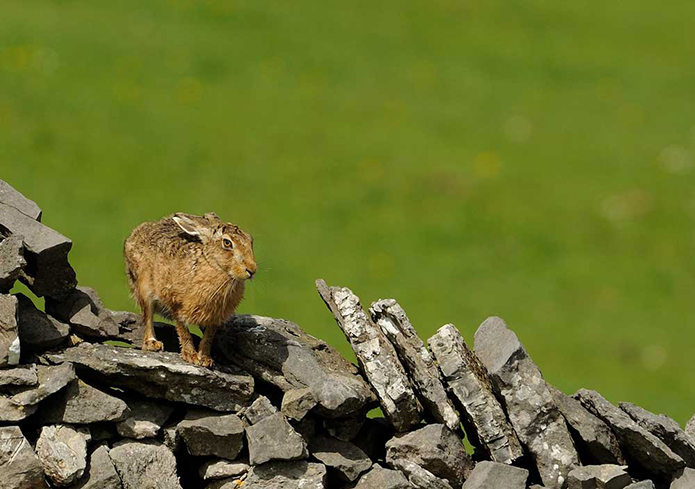
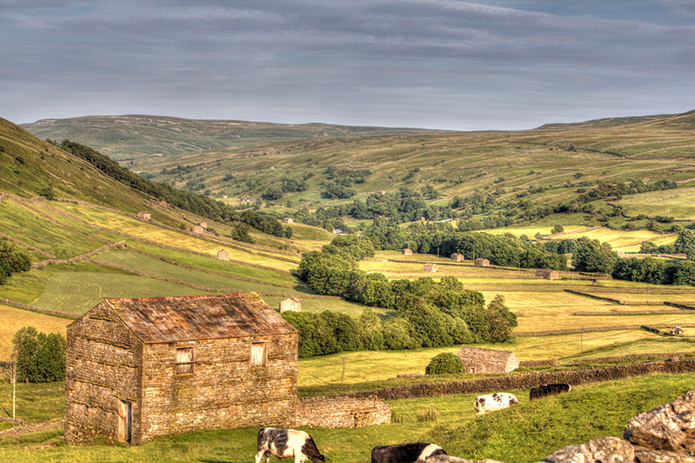

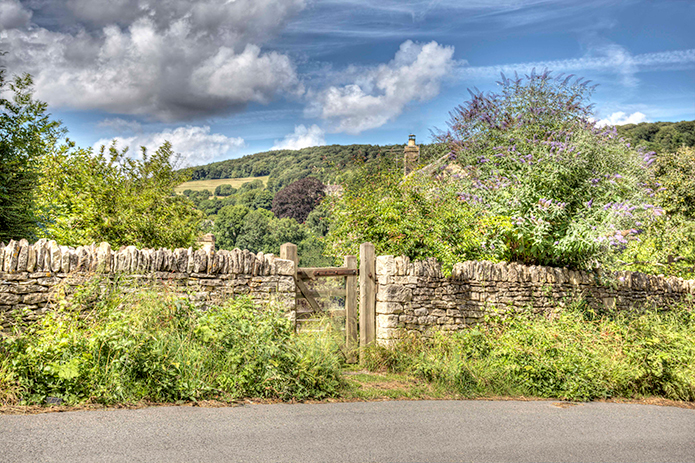
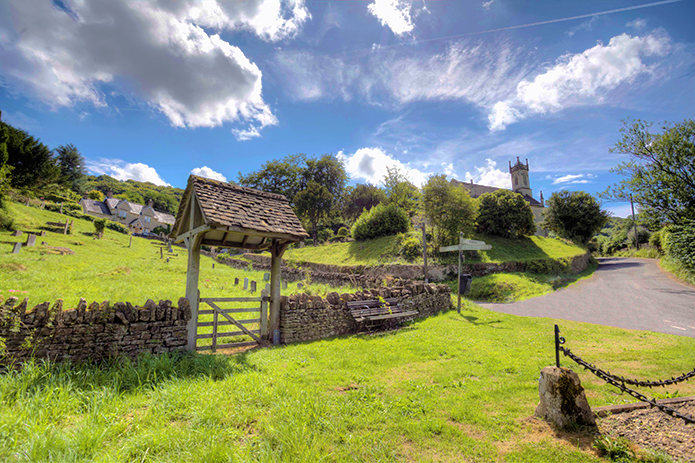
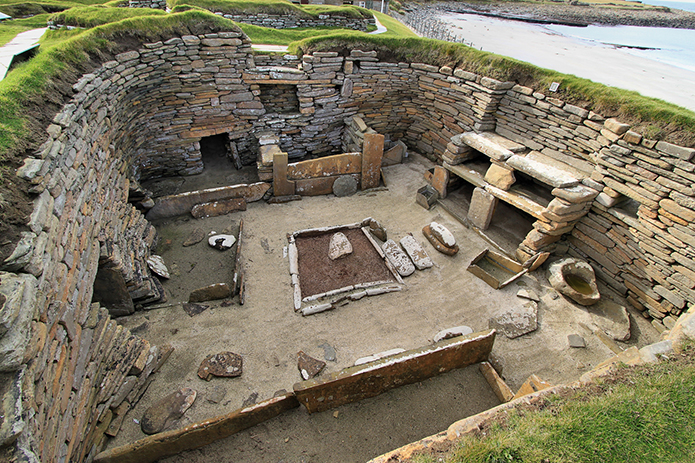
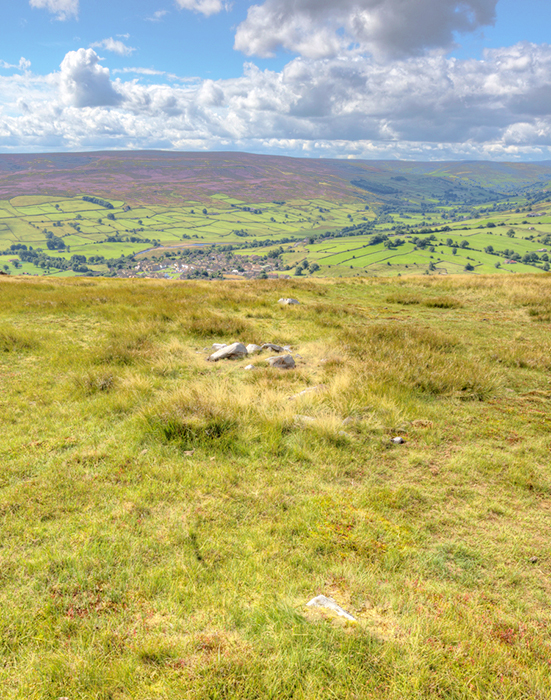
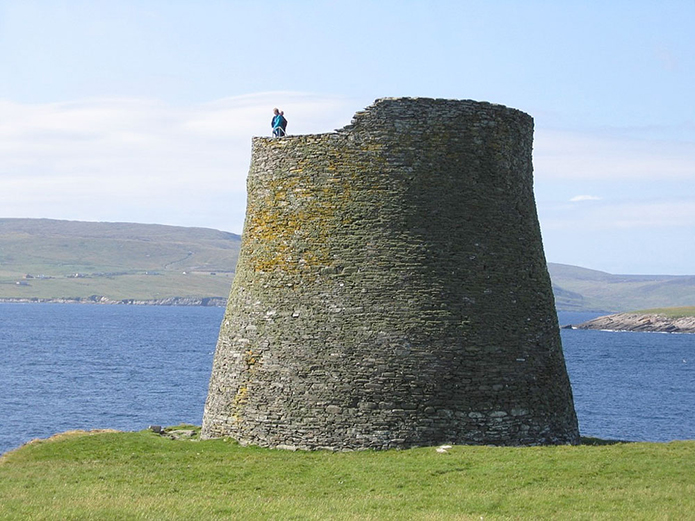

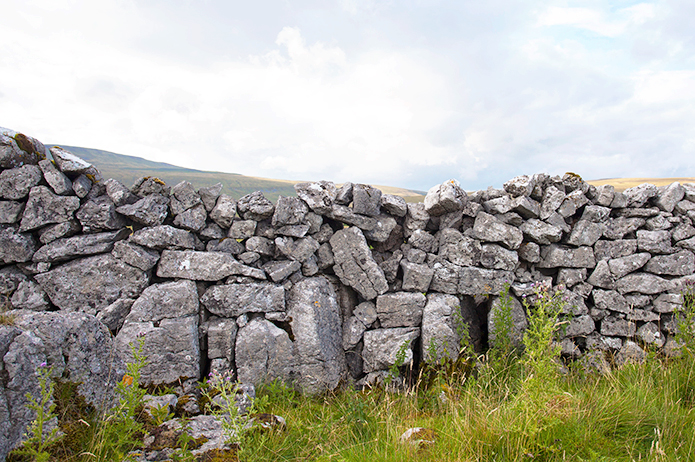
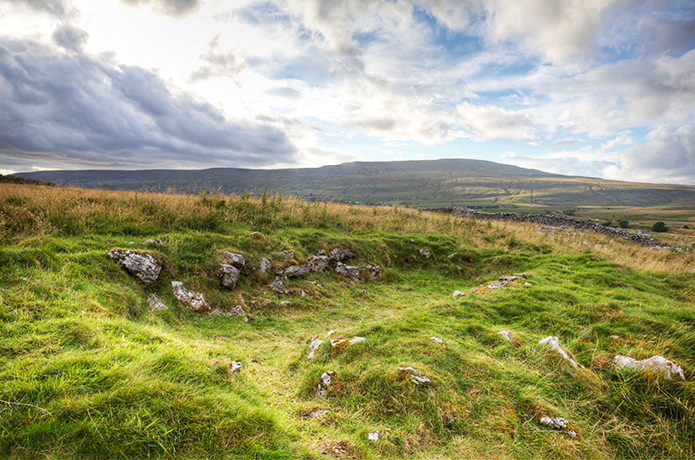

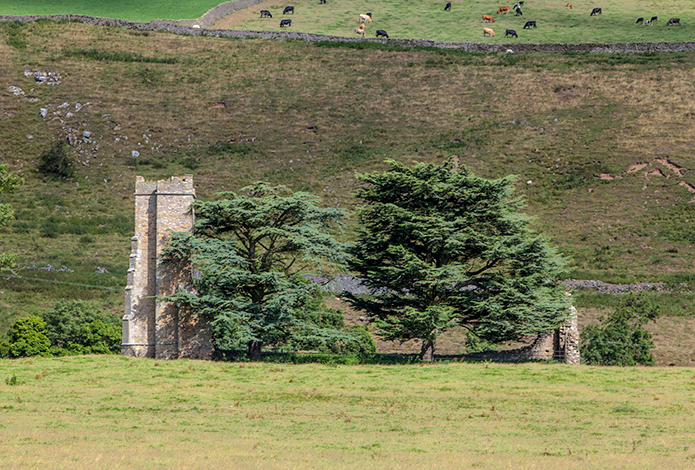
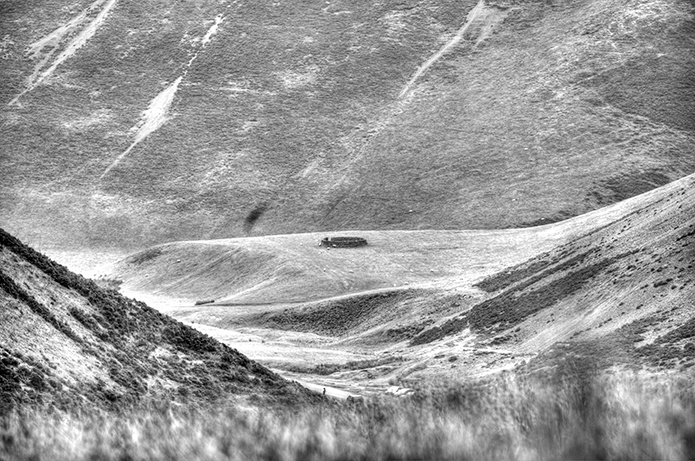
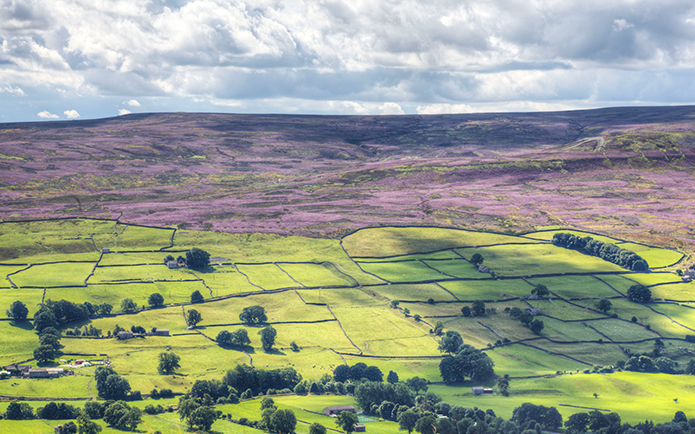
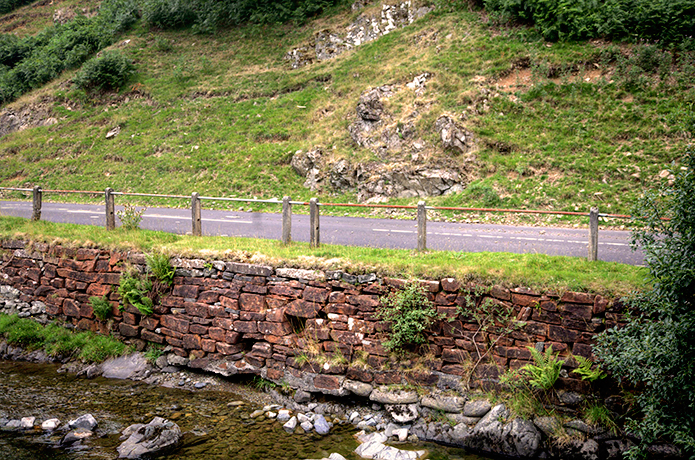
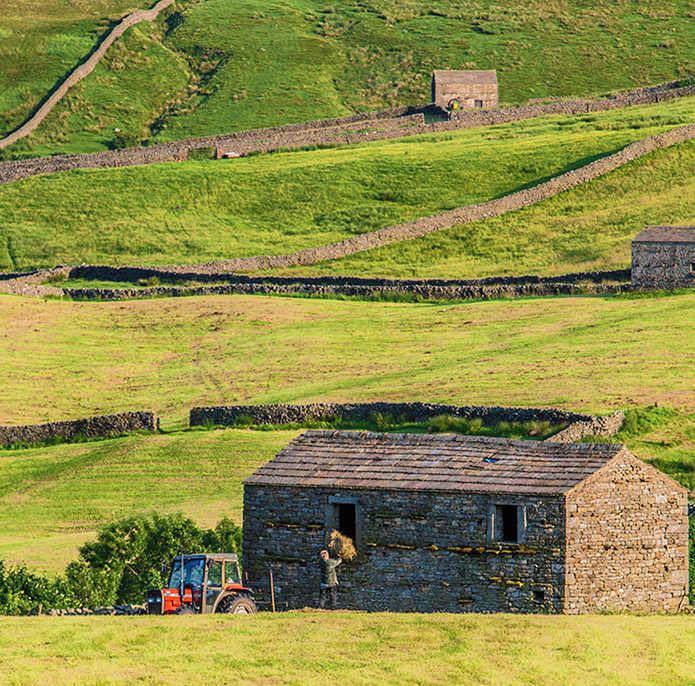
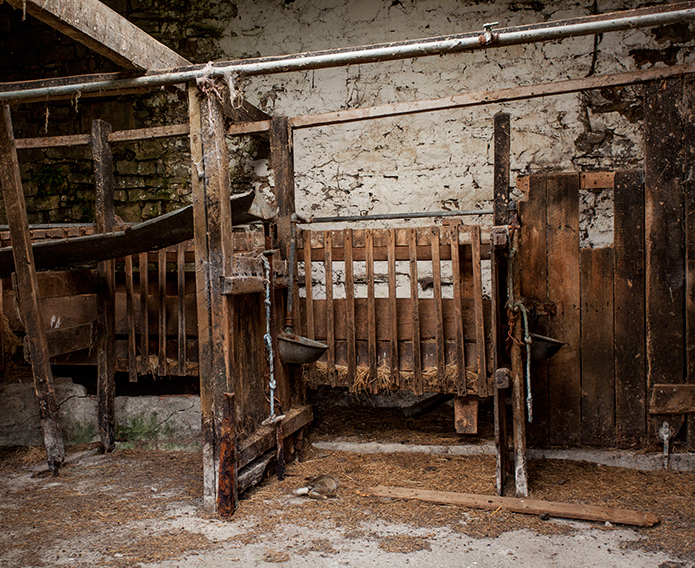
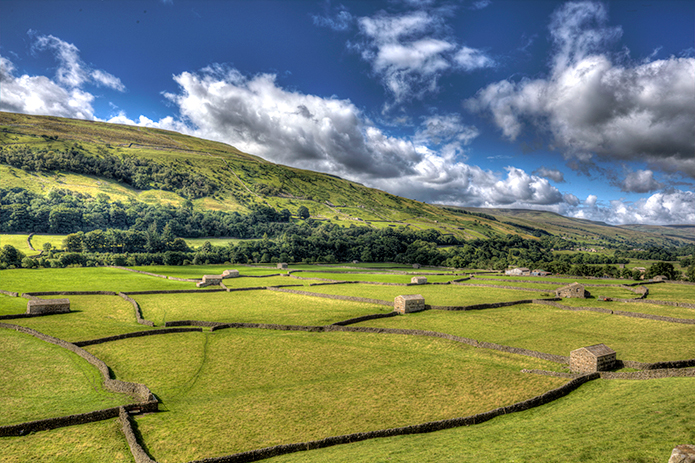
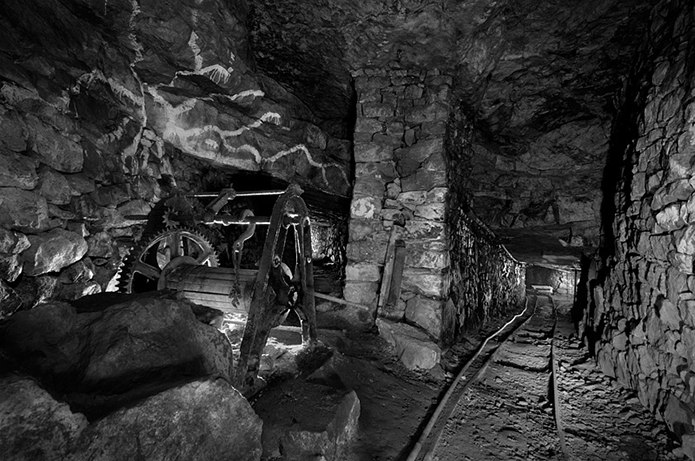
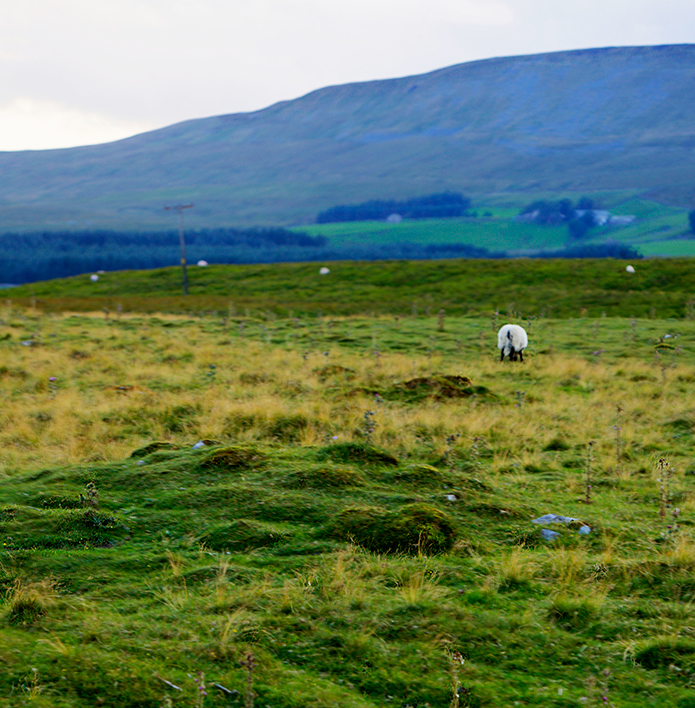
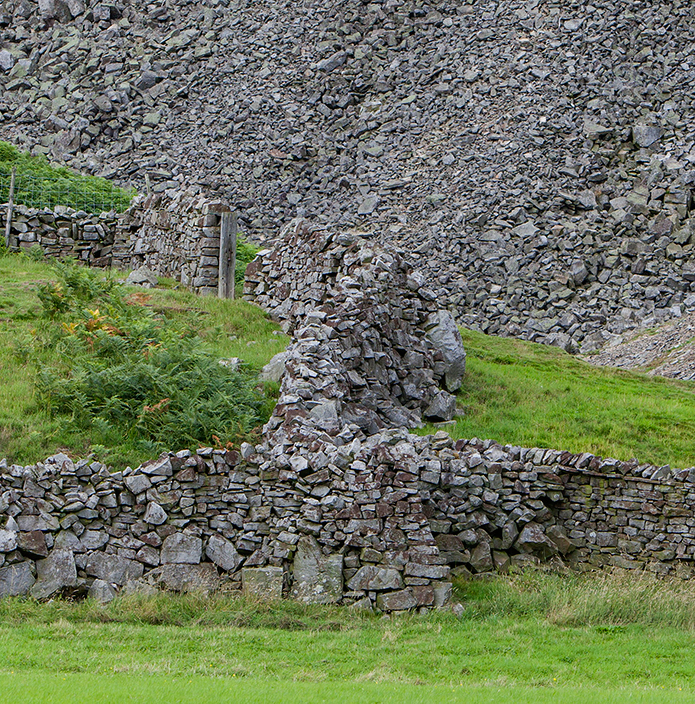
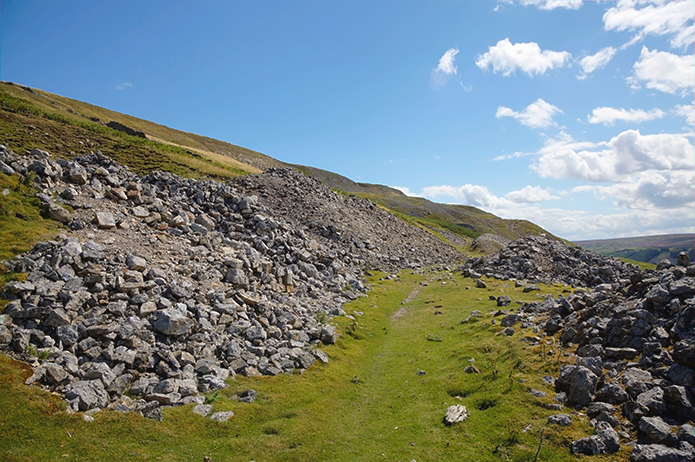
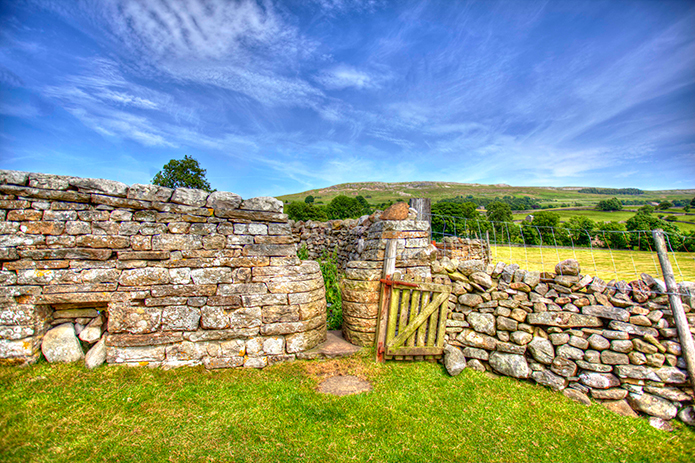

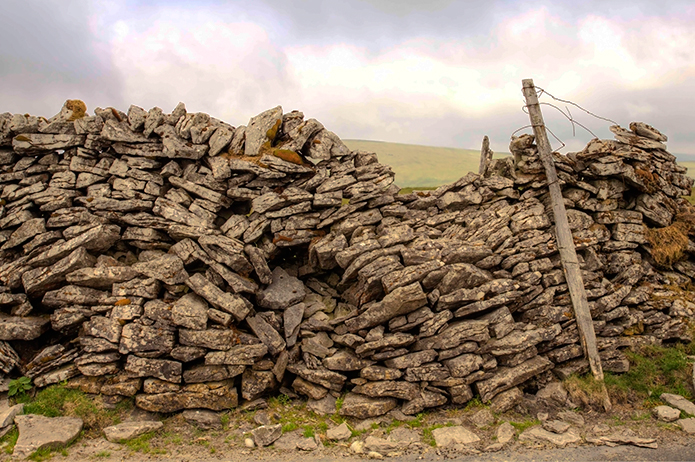
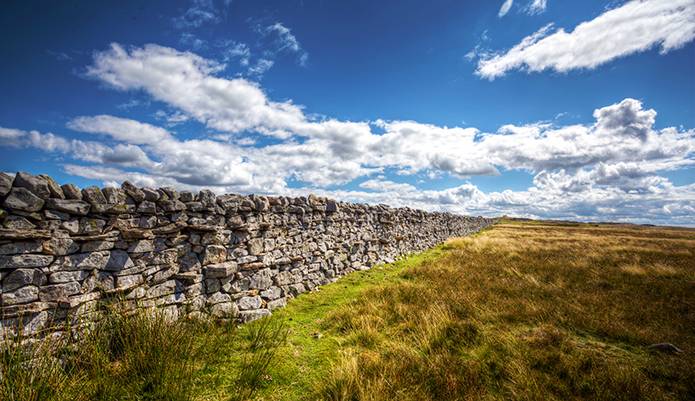
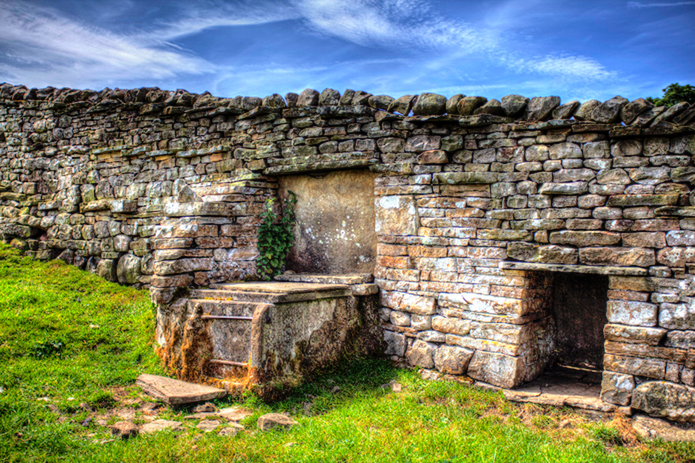
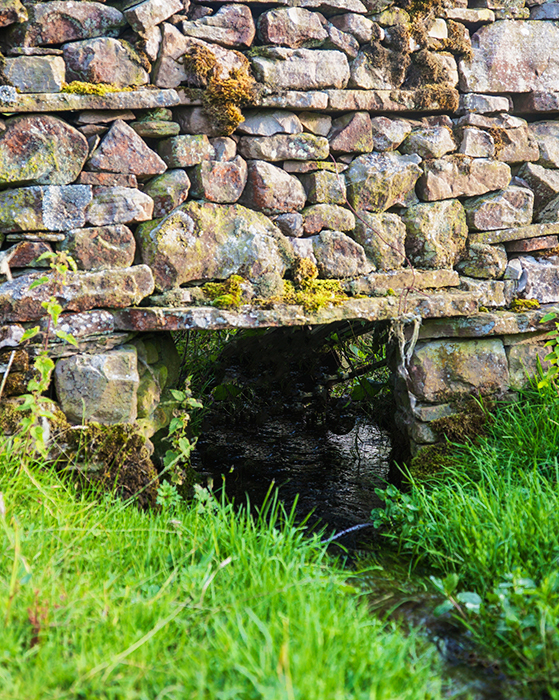
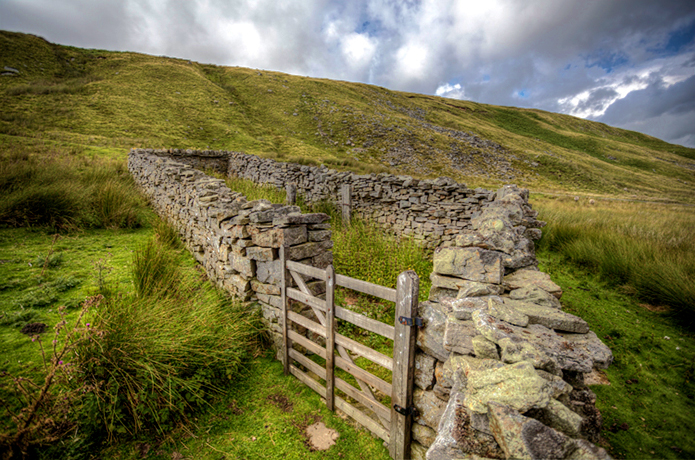
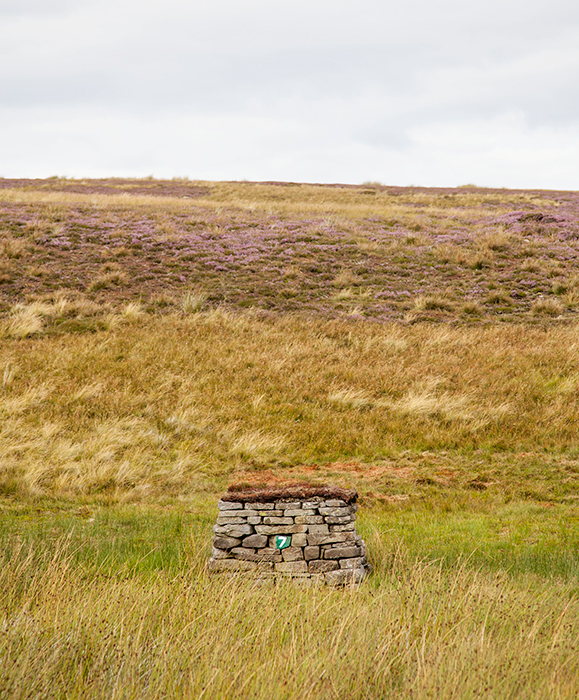
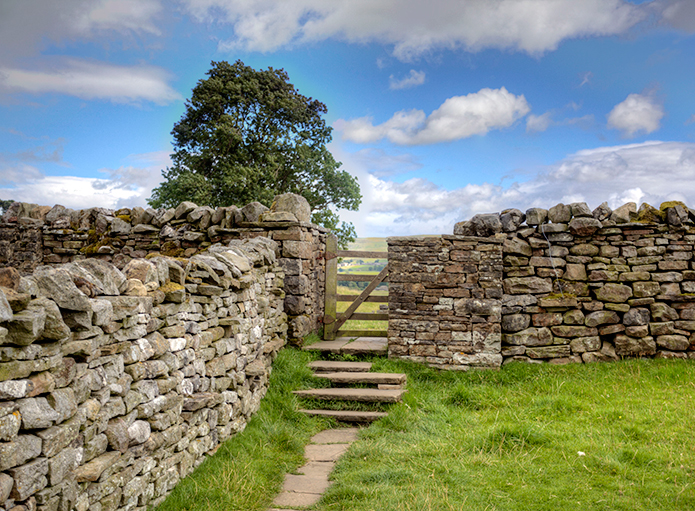
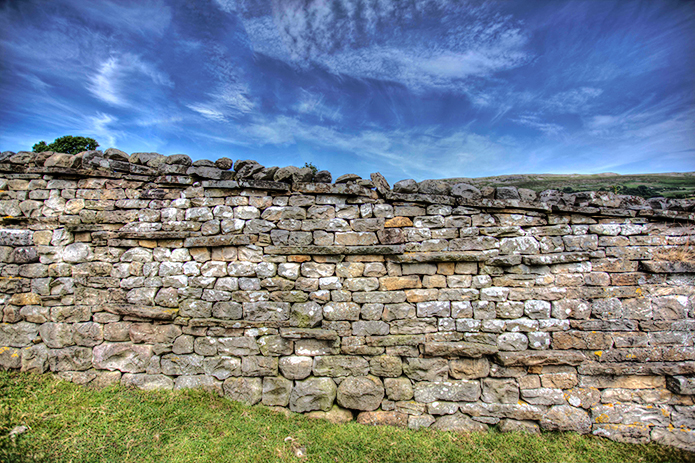
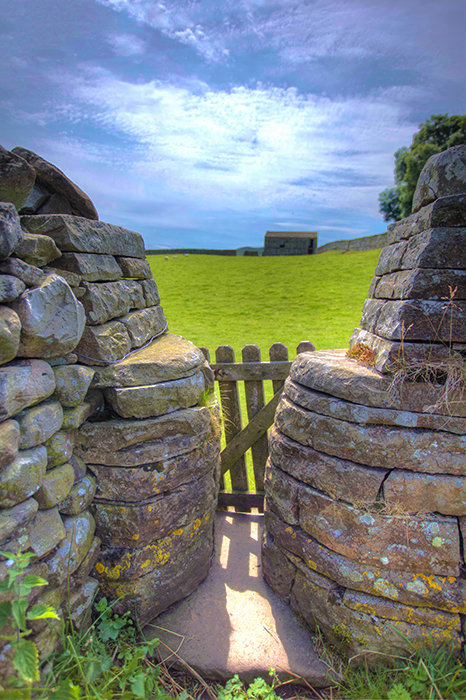
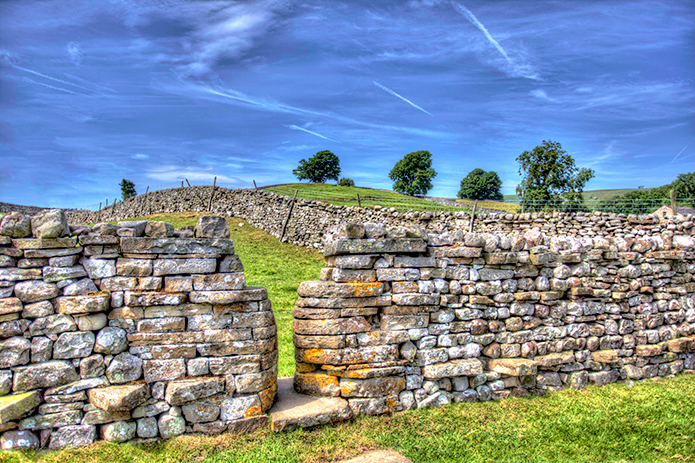
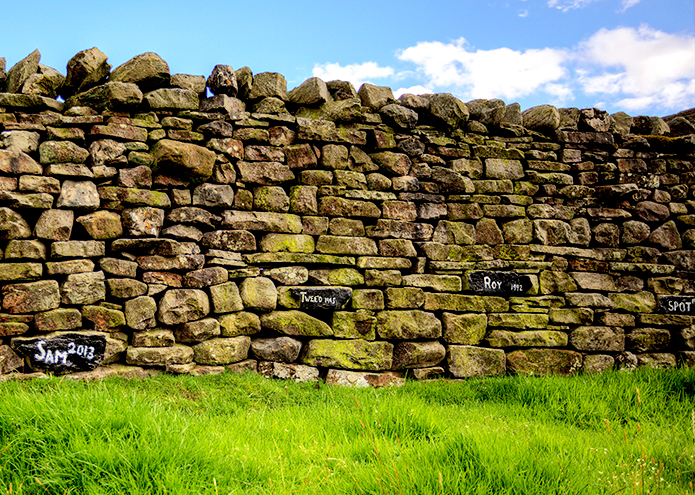
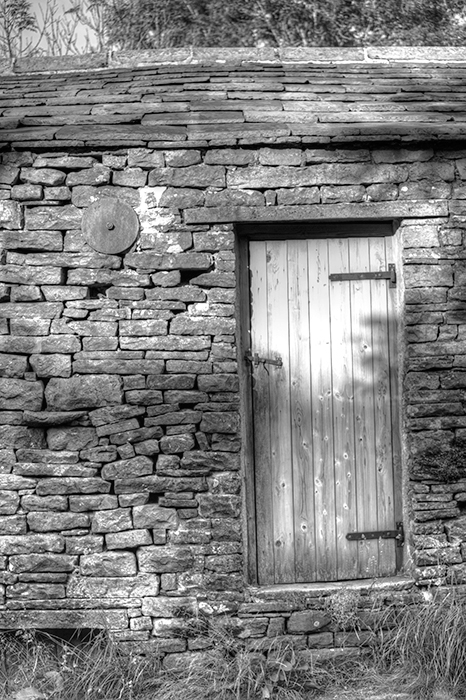
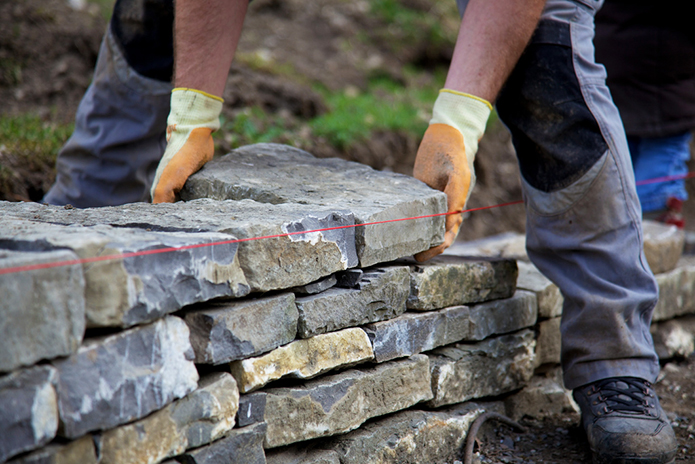
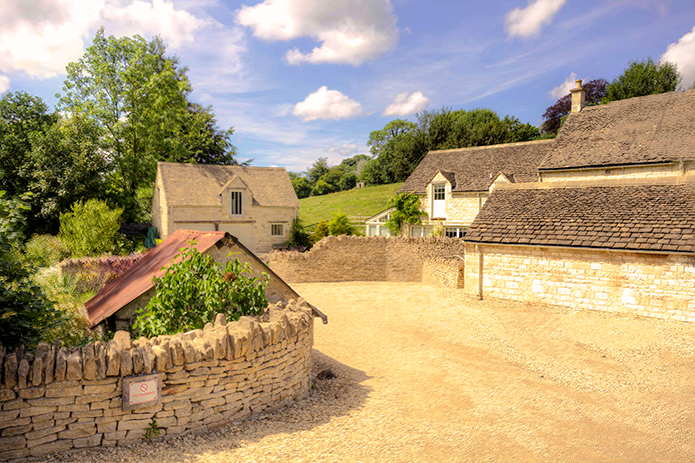









Saturday, April 4th 2020 at 9:17 am
[…] Section of dry stone walling nr Askrigg, Yorkshire Dales. An insight into the history, craft and splendour of dry stone walling by Merchant & Makers. See more at: http://www.merchantandma… […]
Wednesday, August 21st 2019 at 5:14 pm
[…] Collapsed Stone Wall. Source: Gerry Jones via Merchants and Makers […]
Tuesday, April 24th 2018 at 10:55 pm
[…] along the front fenceline, probably next year, because I’ve been fascinated with the idea of dry-stone walls from old Viking-lands, particularly in Ireland and the western coastal areas of Britain. This and […]
Monday, August 21st 2017 at 12:16 pm
[…] Mississippi grating hated every minute of his day. He hated being indoors and he hated what he did. Greensboro drain cover was walking along the street and happened by someone playing music on a guitar and singing. […]
Tuesday, August 15th 2017 at 7:36 am
[…] drainage water drain grates Putting half of a cup of vinegar into a spray bottle and spraying it onto a window or other surface […]
Friday, February 26th 2016 at 11:14 am
[…] Schotland. Bron: Merchant & Makers. […]